The Hamgyeong Line was a railway line of the Chosen Government Railway (Sentetsu) in Japanese-occupied Korea, running from Wonsan to Sangsambong. Construction began in 1914, and was completed in 1928. The line is now entirely within North Korea; the Korean State Railway has divided it between the Kangwŏn Line, the P'yŏngra Line, the Kangdŏk Line (Namgangdŏk−Suseong), and the Hambuk Line.
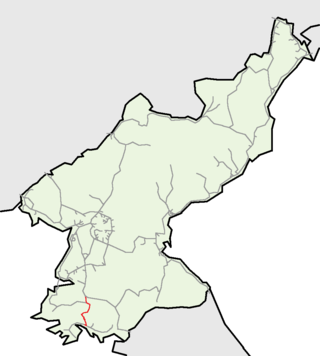
The Hwanghae Ch'ŏngnyŏn Line is an electrified standard-gauge secondary line of the Korean State Railway in the North and South Hwanghae provinces of North Korea, running from Sariwŏn to Haeju. It connects to the P'yŏngbu Line at Sariwŏn, to the Ŭnnyul Line at Ŭnp'a, to the Paech'ŏn Line at Changbang, and to the Ongjin Line at Haeju. It plays an important role in the transportation of freight and passengers in North and South Hwanghae provinces, serving important mining and industrial areas, as well as one of the DPRK's most important ports for foreign trade.
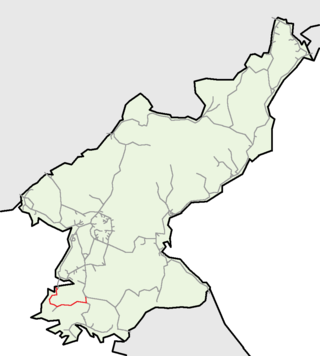
The Ŭnnyul Line is a non-electrified standard-gauge secondary line of the Korean State Railway in the North and South Hwanghae provinces of North Korea, running from Ŭnp'a to Ch'ŏlgwang. It is an important line in economic terms, connecting the agricultural and ore-producing areas of Kwail and Ŭnnyul counties with the rest of the DPRK.
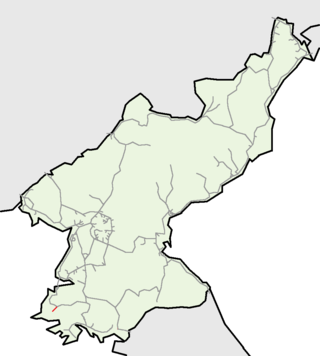
The Changyŏn Line is a non-electrified standard-gauge secondary line of the Korean State Railway running from Sugyo on the Ŭnnyul Line to Changyŏn, South Hwanghae Province, North Korea.
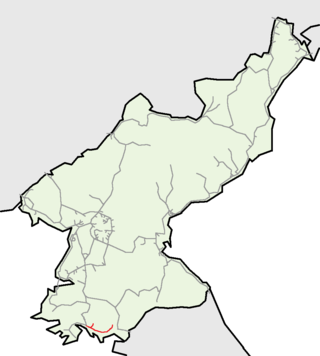
The Paech'ŏn Line is a partially electrified standard-gauge secondary railway line of the Korean State Railway in South Hwanghae Province, North Korea, running from Changbang on the Hwanghae Ch'ŏngnyŏn Line to Ŭnbit.
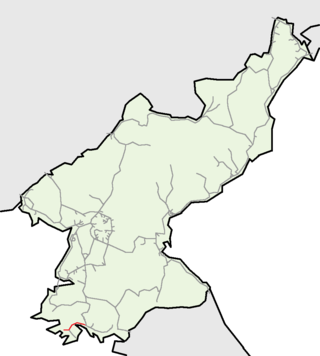
The Ongjin Line is a partially electrified standard-gauge secondary line of the Korean State Railway in South Hwanghae Province, North Korea, running from Haeju on the Hwanghae Ch'ŏngnyŏn Line to Ongjin.

The Changjin Line (Korean: 장진선) is an electrified narrow gauge line of the North Korean State Railway running from Yŏnggwang on the Sinhŭng Line to Sasu on Lake Changjin. There is a 7.4 km (4.6 mi) cable-hauled section between Samgo and Hwangch'oryong; between Pojang and Hwangch'oryong the grade reaches 370‰.

The Manp'o Line is an electrified standard-gauge trunk line of the North Korean State Railway running from Sunch'ŏn on the P'yŏngra Line to Manp'o on the Pukpu Line. The line continues on from Manp'o to Ji'an, China.
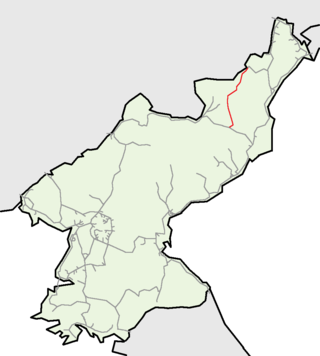
The Paengmu Line is a partially electrified narrow gauge line of the Korean State Railway running from Paeg'am on the Paektusan Ch'ŏngnyŏn Line to Musan on the Musan Line, in the Ryanggang and North Hamgyŏng provinces of North Korea.
The Ryongsŏng Line is an electrified standard-gauge secondary line of the Korean State Railway in P'yŏngyang, North Korea, running from Sŏp'o on the P'yŏngŭi Line to Tongbungri on the P'yŏngra Line. From Ryongsŏng, this line also has a line connecting to the private railway station attached to Residence No. 55, the primary residence of Kim Jong-un. The maintenance facilities for the North Korean leaders' trains are also located at Ryongsŏng Station.
The Sinheung Railway, was a privately owned railway company in colonial era Korea.
The Dasado Railway, was a privately owned railway company in Japanese-occupied Korea.

The Kangan Line, also spelled Kang'an Line, is a non-electrified standard-gauge freight-only secondary line of the Korean State Railway located entirely within Sinŭiju-si, North P'yŏngan Province, North Korea, running from Sinŭiju on the P'yŏngŭi Line to Kang'an.
The Chŏngdo Line is an electrified standard-gauge secondary line of the Korean State Railway in South Hwanghae Province, North Korea, running from Wangsin station on the Ongjin Line to Chŏngdo station.
The Gyeongui Line was a railway line of the Chosen Government Railway running from Keijō to Sinuiju in Korea, Empire of Japan. After the partition of Korea in 1945, the line was divided between North and South Korea.
The Yangsi Line was a non-electrified standard-gauge railway line of the Korean State Railway in North P'yŏngan Province, North Korea, running from Namsi (Yŏmju) on the P'yŏngŭi Line to South Sinŭiju, likewise on the P'yŏngŭi Line, with which it was merged in 1964.

The North Chōsen Colonial Railway, was a privately owned railway company in Japanese-occupied Korea.
Hwanghae Line was the name given by the privately owned Chōsen Railway of colonial Korea to its network of railway lines in Hwanghae Province. The name encompassed the mainline from Sariwon to Haeju, along with several connecting branch lines.
The Songheung Line was a 762 mm (30.0 in) narrow gauge railway line of the Chōsen Railway (Chōtetsu) of colonial-era Korea, located in South Hamgyeong Province. There was a 550 m (1,800 ft) cable-hauled section between Baekamsan and Hamnam Songheung.
The Gyeongbuk Line was a railway line of the privately owned Chōsen Railway (Chōtetsu) in colonial-era Korea, located in North Gyeongsang Province, connecting Gimcheon with Gyeongbuk Andong.













